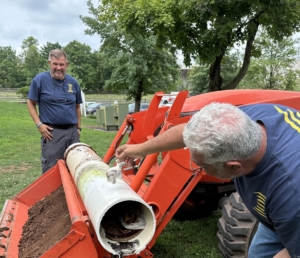What We Do
Resources
© Copyright 2024 – NSU, Natural Systems Utilities
Natural Systems Utilities (NSU), a new BPC 2024 business partner, is an environmental firm specializing in the design, construction, and operations of decentralized water treatment, wastewater treatment, and water reuse solutions, including Innovative and Alternative (I/A) Systems. Working with private, municipal, institutional, and commercial entities, NSU helps its clients meet long-term stewardship and sustainability goals. NSU’s mission statement is one that BPC members can really get excited about: “To reimagine water by providing innovative solutions that safeguard the world’s water resources.”
Established in 1984 and headquartered in New Jersey, NSU’s original focus for expansion was in the Northeast, where it has had a presence in Massachusetts for over 25 years. NSU’s 2019 purchase of Bennett Environmental Associates, a Brewster-based environmental engineering firm established by Brewster resident Dave Bennett, is how the BPC connected with NSU when its Vice President, Adam Stern, attended the BPC-sponsored talk given by Mr. Bennett titled “Decentralized Wastewater Management” at the Brewster Ladies Library last spring. NSU has additional offices in California and Minnesota.
A fan of Cape Cod, Adam has been coming to the Cape for years. His earliest memories are of walking out onto the sands at low tide in Ptown. He has been at NSU for 30 years and has led the engineering and construction groups, and currently serves in a Business
Development role.
As Natural Systems Utilities (NSU) proudly marks its 40th anniversary, we recently took a nostalgic journey back in time by opening a time capsule buried 25 years ago. This special occasion not only celebrates four decades of growth and innovation but also highlights the enduring dedication of our team members who have been the backbone of our success.
A Glimpse into the Past

The time capsule, carefully sealed and buried a quarter-century ago, was unearthed with much anticipation. What lay inside offered a fascinating glimpse into the world of the 1990s and the early days of our company. Among the items discovered were:
– Newspapers: These papers provided a snapshot of the world as it was 25 years ago, capturing the headlines and major events of the time. It was a reminder of how much has changed in the world, and in our industry, since then.
– Desk Phone: A classic symbol of pre-digital communication, the desk phone served as a reminder of how far technology has come. The transition from these phones to today’s sophisticated communication tools reflects the rapid advancements in our field.
– Floppy Disk: Once a staple for data storage, the floppy disk represented the early days of digital information management. Today, we’ve moved to cloud-based systems and cutting-edge technology, but it’s fascinating to see where we started.
– Ford L8000 Diesel Truck Badge: This 1980s emblem from a Ford L8000 Diesel truck was a testament to the equipment and machinery that supported our early operations. It symbolized the hard work and dedication that went into building our infrastructure.
– Branded Items from Applied Water Management: Before becoming Natural Systems Utilities, we operated under the name Applied Water Management. The branded items from this earlier era were a poignant reminder of our roots and the foundational values that have guided us through the years.
Reflecting on Our Journey

As we look back, it’s evident that our journey has been marked by significant milestones and remarkable achievements. From our humble beginnings as Applied Water Management to becoming Natural Systems Utilities, our evolution reflects not just technological progress but also the unwavering commitment of our employees.
Our success is deeply intertwined with the hard work, dedication, and passion of our team members—both past and present. Their commitment to our clients and to advancing our mission has been instrumental in our growth and achievements.
A Heartfelt Thank You

To all our employees, past and present, we extend our deepest gratitude. Your tireless efforts and steadfast dedication have been crucial in shaping our company’s history and success. This milestone is not just a celebration of our past but also a tribute to the incredible people who have made it all possible.
Looking Forward

As we celebrate this 40th anniversary and reflect on the past, we are also excited about the future. The time capsule serves as a reminder of how far we’ve come and inspires us to continue pushing boundaries and striving for excellence.
Thank you for being an integral part of Natural Systems Utilities’ journey. Here’s to many more years of innovation, growth, and success. Together, we’ll continue to advance our mission of providing exceptional water management solutions.
#MissionWater

In the pursuit of sustainable water management, design-build water reuse projects are emerging as innovative solutions to address the pressing challenges of water scarcity and pollution. By integrating engineering expertise with holistic design principles, these projects harness the potential of water reuse to transform wastewater into a valuable resource. In this blog, we explore the concept of design-build water reuse, its benefits, implementation strategies, and the transformative impact it holds for creating more resilient and sustainable water systems.
Understanding Design-Build Water Reuse
Design-build water reuse involves a collaborative approach that integrates the design, construction, and operation of water reuse systems into a single, streamlined process. Unlike traditional project delivery methods that separate design and construction phases, design-build projects leverage interdisciplinary teams to optimize efficiency, minimize costs, and accelerate project delivery.
The Benefits of Design-Build Water Reuse
Enhanced Collaboration and Efficiency
Design-build projects foster collaboration between designers, engineers, contractors, and stakeholders from project inception to completion. By integrating diverse perspectives and expertise, these projects streamline decision-making processes, reduce project timelines, and enhance overall efficiency.
Customized Solutions and Innovation
Design-build approaches allow for flexibility and creativity in developing tailored water reuse solutions to meet specific project goals and site constraints. By fostering innovation and adaptive design principles, design-build projects can incorporate cutting-edge technologies and best practices to optimize system performance and maximize resource recovery.
Cost Savings and Risk Management
Design-build delivery methods offer potential cost savings by minimizing change orders, reducing project delays, and optimizing construction schedules. By bundling design and construction services under a single contract, design-build projects streamline project management and mitigate risks associated with coordination errors and communication breakdowns.
Strategies for Implementing Design-Build Water Reuse
Comprehensive Needs Assessment
Thorough site assessments and stakeholder engagement are essential for understanding project requirements, identifying water reuse opportunities, and defining project objectives. Conducting feasibility studies and risk assessments can help inform decision-making and guide the development of cost-effective and sustainable water reuse solutions.
Integrated Design and Planning
Integrating design and planning processes from the outset enables project teams to consider multiple factors, including site conditions, regulatory requirements, water quality objectives, and end-user needs. Adopting a holistic approach to design and planning facilitates the development of resilient and adaptable water reuse systems that optimize resource utilization and minimize environmental impacts.
Performance Monitoring and Optimization
Continuous monitoring and evaluation of water reuse systems are critical for ensuring operational efficiency, maintaining water quality standards, and identifying opportunities for optimization. Implementing robust monitoring protocols and data management systems enables project teams to track system performance, identify trends, and make informed decisions to enhance system reliability and effectiveness.
Conclusion: Shaping a Sustainable Water Future
Design-build water reuse projects represent a paradigm shift in water management, offering integrated solutions to address water scarcity, enhance resilience, and promote environmental sustainability. By leveraging interdisciplinary collaboration, innovative design principles, and adaptive management approaches, these projects have the potential to transform wastewater into a valuable resource for communities, industries, and ecosystems.
As we confront the challenges of a rapidly changing world, embracing design-build water reuse approaches is essential for creating resilient, resource-efficient water systems that meet the needs of present and future generations. Through strategic planning, stakeholder engagement, and a commitment to innovation, we can harness the power of design-build water reuse to build a more sustainable and water-secure future for all.
In the face of environmental challenges, the importance of sustainability has become increasingly evident. Among the myriad of issues, water scarcity stands out as a critical concern, prompting innovative solutions across various sectors. College campuses, as hubs of education and innovation, have a unique opportunity to lead by example in implementing sustainable practices. One such practice gaining traction is water reuse.
The Imperative of Water Reuse
Water scarcity is a pressing global issue exacerbated by factors like climate change, population growth, and inefficient water management. According to the United Nations, by 2025, an estimated 1.8 billion people will be living in regions with absolute water scarcity, with two-thirds of the world’s population potentially facing water-stressed conditions. In this context, finding sustainable ways to manage and conserve water resources is paramount.
College campuses, with their substantial water consumption due to academic, residential, and recreational activities, can significantly contribute to water conservation efforts. Implementing water reuse systems not only reduces water demand but also promotes a culture of environmental responsibility among students, faculty, and staff.
Strategies for Water Reuse
Greywater Recycling
Greywater, wastewater generated from activities like bathing, laundry, and dishwashing, can be treated and reused for non-potable purposes such as landscape irrigation, toilet flushing, and cooling systems. Installing greywater recycling systems on college campuses offers a practical way to minimize freshwater consumption for non-drinking purposes.
Rainwater Harvesting
Rainwater harvesting involves collecting and storing rainwater for later use. College campuses can utilize rainwater for landscaping, flushing toilets, and other non-potable applications. Implementing rainwater harvesting systems not only reduces reliance on municipal water sources but also mitigates stormwater runoff, which can help prevent pollution of local water bodies.
Onsite Wastewater Treatment
Onsite wastewater treatment facilities can treat sewage and wastewater generated on campus to a quality suitable for non-potable reuse. These systems utilize various treatment processes such as filtration, biological treatment, and disinfection to purify wastewater. By treating and reusing wastewater locally, colleges can reduce their environmental impact and decrease their dependence on centralized wastewater treatment facilities.
Benefits of Water Reuse on College Campuses
Environmental Sustainability
Implementing water reuse systems helps colleges reduce their environmental footprint by conserving precious freshwater resources and minimizing wastewater discharge into the environment. By adopting sustainable water management practices, campuses can contribute to the preservation of ecosystems and biodiversity.
Cost Savings
Water reuse initiatives can lead to significant cost savings for college campuses in the long run. By reducing water consumption and wastewater discharge, colleges can lower their utility bills and operational expenses. Additionally, investing in water reuse infrastructure may qualify campuses for government incentives or rebates, further enhancing financial benefits.
Educational Opportunities
Water reuse initiatives provide valuable learning opportunities for students across various disciplines, including environmental science, engineering, and sustainability studies. Incorporating water reuse projects into curricula allows students to gain practical experience and develop skills relevant to addressing real-world environmental challenges.
Conclusion
Water reuse presents a sustainable solution for college campuses to manage water resources efficiently and reduce their environmental impact. By implementing greywater recycling, rainwater harvesting, onsite wastewater treatment, and other water reuse strategies, campuses can promote environmental sustainability, achieve cost savings, and provide educational opportunities for students. As stewards of the future, colleges have a responsibility to lead by example and inspire positive change in water management practices. Through collective efforts, we can create a more sustainable and resilient future for generations to come.
In the quest for sustainable water management, innovative approaches are essential to address the pressing challenges of water scarcity and pollution. Among these approaches, black water reuse stands out as a pioneering solution with the potential to revolutionize how we manage wastewater. In this blog, we delve into the concept of black water reuse, its benefits, challenges, and its role in creating a more sustainable future.
Understanding Black Water Reuse
Black water refers to wastewater generated from toilets, kitchen sinks, and dishwashers, containing organic matter and pathogens. Traditionally, black water is treated in centralized wastewater treatment plants before being discharged into water bodies. However, this process consumes significant energy and resources, and the treated water is typically not reused due to concerns about its quality.
Black water reuse involves treating and purifying wastewater from toilets and other sources to a level suitable for non-potable applications such as landscape irrigation, toilet flushing, and industrial processes. Advanced treatment technologies, including membrane filtration, ultraviolet disinfection, and biological processes, are employed to remove contaminants and pathogens, producing high-quality reclaimed water.
Benefits of Black Water Reuse
Water Conservation
Black water reuse conserves freshwater resources by reducing the demand for potable water. Instead of using drinking water for non-potable purposes like irrigation and flushing toilets, reclaimed black water can fulfill these needs, alleviating pressure on strained water supplies.
Nutrient Recovery
Black water contains valuable nutrients such as nitrogen and phosphorus, which can be recovered and reused as fertilizer in agriculture or landscaping. By capturing and recycling these nutrients, black water reuse closes the loop in nutrient management, reducing reliance on synthetic fertilizers and minimizing nutrient pollution in water bodies.
Energy Savings
Traditional wastewater treatment consumes significant energy for pumping, aeration, and treatment processes. By decentralizing treatment through on-site or community-scale black water reuse systems, energy consumption can be reduced, leading to lower carbon emissions and operational costs.
Challenges and Considerations
Regulatory Framework
Implementing black water reuse systems requires navigating complex regulatory frameworks governing water quality and reuse. Regulatory agencies may have stringent requirements for water treatment and quality standards, posing challenges for widespread adoption of black water reuse technologies.
Public Perception
Overcoming public perception and acceptance barriers is crucial for the success of black water reuse initiatives. Despite technological advancements ensuring the safety and quality of reclaimed water, concerns about health risks and stigma associated with wastewater reuse persist among stakeholders.
Infrastructure and Investment
Deploying black water reuse infrastructure entails significant upfront investment in treatment technologies, distribution systems, and monitoring equipment. Securing funding and garnering support from stakeholders, including government agencies, utilities, and communities, is essential to overcome financial barriers and scale up adoption.
Conclusion: Embracing Innovation for a Sustainable Future
Black water reuse represents a paradigm shift in wastewater management, offering a sustainable alternative to conventional treatment and disposal practices. By harnessing advanced technologies and fostering collaboration among policymakers, industry stakeholders, and the public, we can overcome challenges and realize the full potential of black water reuse to conserve water, recover valuable resources, and mitigate environmental impacts.
As we confront the urgent challenges of water scarcity and pollution, embracing innovation and adopting holistic approaches to water management are imperative. Black water reuse exemplifies the transformative power of technology and collaboration in shaping a more sustainable and resilient future for generations to come. Let us seize the opportunity to harness the potential of black water reuse and pave the way towards a water-secure world.
In the realm of environmental stewardship, water regulation plays a pivotal role in safeguarding precious water resources and ensuring public health. Over time, these regulations evolve in response to scientific advancements, changing societal needs, and emerging environmental challenges. In this blog, we explore recent water regulation changes in the United States, highlighting key developments and their implications for water management and conservation efforts nationwide.
The Clean Water Act: A Foundation for Environmental Protection
Enacted in 1972, the Clean Water Act (CWA) serves as a cornerstone of water quality regulation in the United States. The CWA aims to restore and maintain the chemical, physical, and biological integrity of the nation’s waters by regulating pollutant discharges into navigable waters and establishing water quality standards. Under the CWA, the Environmental Protection Agency (EPA) sets regulatory guidelines and collaborates with state and tribal governments to enforce water quality standards and implement pollution control programs.
Recent Regulatory Updates and Initiatives
Waters of the United States (WOTUS) Rule
One of the most significant recent developments in water regulation is the revision of the Waters of the United States (WOTUS) rule. The WOTUS rule, originally promulgated in 2015, defines the scope of waters protected under the Clean Water Act. In 2020, the EPA and the Army Corps of Engineers repealed and replaced the 2015 WOTUS rule with the Navigable Waters Protection Rule (NWPR). The NWPR narrows the definition of federally regulated waters, reducing federal oversight over certain ephemeral streams, wetlands, and other water bodies. Proponents argue that the NWPR provides regulatory certainty and reduces federal overreach, while critics express concerns about potential impacts on water quality and habitat protection.
Lead and Copper Rule Revisions
In December 2020, the EPA finalized revisions to the Lead and Copper Rule (LCR), which governs drinking water quality standards and lead contamination in drinking water systems. The updated LCR strengthens testing and reporting requirements, enhances corrosion control measures, and expands public notification and transparency provisions. The revisions aim to improve public health protections and reduce exposure to lead in drinking water, particularly in vulnerable communities disproportionately affected by lead contamination.
PFAS Regulation
Per- and polyfluoroalkyl substances (PFAS) are a group of synthetic chemicals widely used in industrial and consumer products, known for their persistence and potential adverse health effects. Recognizing the growing concern over PFAS contamination, the EPA has initiated regulatory actions to address PFAS pollution in drinking water and the environment. Efforts include monitoring and testing programs, research initiatives, and the development of regulatory standards for PFAS in drinking water and wastewater discharges.
Implications and Future Directions
Recent water regulation changes in the United States reflect ongoing efforts to adapt to evolving environmental and public health challenges. While these updates represent progress towards enhancing water quality and protection, they also raise questions and debates about regulatory effectiveness, stakeholder engagement, and equitable implementation.
As we navigate the waves of change in water regulation, collaboration among government agencies, stakeholders, and communities is essential to address complex water management issues effectively. By fostering dialogue, innovation, and collective action, we can strive towards a future where clean, safe, and accessible water is a fundamental right for all.
In conclusion, staying informed about recent water regulation changes and actively engaging in water policy discussions empowers individuals and communities to contribute to sustainable water management and environmental conservation efforts. Together, we can chart a course towards a more resilient and water-secure future for generations to come.
Water, the elixir of life, sustains ecosystems, nourishes communities, and drives economies. However, as global populations rise, industrialization expands, and climate change intensifies, the specter of water scarcity looms ever larger. In this blog, we delve into the complexities of water scarcity, its causes, impacts, and the urgent need for collective action to secure this precious resource for future generations.
The Anatomy of Water Scarcity
Water scarcity arises when the demand for freshwater exceeds the available supply, leading to competition and conflict over water resources. It manifests in various forms, including physical scarcity, where the quantity of water is insufficient to meet demand, and economic scarcity, where water is available but inaccessible due to infrastructure limitations or financial constraints.
Causes of Water Scarcity
Population Growth
Rapid population growth exacerbates water scarcity by increasing water demand for drinking, sanitation, agriculture, and industry. As urbanization accelerates and rural-to-urban migration intensifies, the strain on water resources intensifies, particularly in densely populated regions.
Climate Change
Climate change disrupts precipitation patterns, exacerbating droughts, floods, and extreme weather events. Rising temperatures accelerate evaporation rates, diminish snowpack, and alter hydrological cycles, reducing water availability in many regions and exacerbating water stress.
Unsustainable Water Management
Inefficient water use practices, over-extraction of groundwater, pollution of water sources, and inadequate infrastructure contribute to water scarcity. Poor governance, lack of regulation, and competing interests further exacerbate water management challenges, perpetuating water scarcity and inequality.
Impacts of Water Scarcity
Environmental Degradation
Water scarcity threatens ecosystems, leading to habitat loss, biodiversity decline, and degradation of freshwater ecosystems. Reduced water availability affects aquatic species, disrupts migration patterns, and exacerbates ecosystem imbalances, jeopardizing the services they provide.
Socioeconomic Disparities
Water scarcity disproportionately impacts vulnerable populations, exacerbating poverty, food insecurity, and social inequality. Limited access to clean water and sanitation undermines health outcomes, hinders economic development, and perpetuates cycles of poverty and deprivation.
Conflict and Migration
Competition over water resources can exacerbate tensions between communities, regions, and nations, leading to conflict and displacement. Water-related disputes over transboundary rivers, shared aquifers, and access to water infrastructure pose significant geopolitical challenges and security risks.
Addressing Water Scarcity: A Call to Action
Sustainable Water Management
Promoting water conservation, efficiency, and reuse is essential for mitigating water scarcity and ensuring sustainable water management. Investing in water-saving technologies, improving irrigation practices, and implementing integrated water resource management approaches can enhance water resilience and alleviate pressure on finite water resources.
Climate Adaptation and Resilience
Adapting to climate change and building resilience to its impacts is critical for addressing water scarcity. Implementing climate-smart agricultural practices, restoring watersheds, and investing in climate-resilient infrastructure can enhance water security and minimize vulnerability to extreme weather events.
Collaboration and Governance
Addressing water scarcity requires collaboration and cooperation among stakeholders, including governments, communities, businesses, and civil society organizations. Strengthening water governance frameworks, fostering stakeholder engagement, and promoting equitable access to water resources are essential for addressing the root causes of water scarcity and building a more sustainable water future.
Conclusion: A Shared Responsibility
Water scarcity is a complex and multifaceted challenge that demands urgent action and collective solutions. By understanding its causes, addressing its impacts, and prioritizing sustainable water management practices, we can chart a course towards a more water-secure and resilient future for all.
As stewards of this precious resource, we each have a role to play in conserving water, promoting equitable access, and advocating for policies that prioritize water security. Together, let us rise to the challenge of water scarcity with determination, innovation, and solidarity, ensuring that future generations inherit a world where water is abundant, accessible, and sustainably managed.
In the pursuit of sustainability, technology campuses are emerging as pioneers in adopting innovative solutions to address environmental challenges. Among these solutions, water reuse stands out as a promising approach to reduce water consumption, minimize environmental impact, and promote responsible resource management. In this blog, we delve into the concept of water reuse at tech campuses, exploring its benefits, implementation strategies, and the transformative potential it holds for creating more sustainable environments.
The Nexus of Technology and Sustainability
Tech campuses, often bustling hubs of innovation and creativity, have a unique opportunity to lead by example in integrating sustainable practices into their operations. With a focus on cutting-edge technologies and forward-thinking initiatives, these campuses are well-positioned to implement water reuse systems and showcase their efficacy in conserving water resources and reducing environmental footprint.
Benefits of Water Reuse at Tech Campuses
Conservation of Freshwater Resources
Water reuse systems enable tech campuses to reduce their reliance on freshwater sources by treating and recycling wastewater for non-potable purposes. By utilizing reclaimed water for activities such as landscape irrigation, cooling systems, and toilet flushing, campuses can significantly decrease their demand for potable water and contribute to water conservation efforts.
Environmental Stewardship
Implementing water reuse systems aligns with tech campuses’ commitment to environmental sustainability and corporate social responsibility. By reducing wastewater discharge and minimizing the environmental impact associated with conventional water treatment and disposal practices, campuses can demonstrate their dedication to protecting natural ecosystems and mitigating climate change.
Cost Savings and Efficiency
Water reuse initiatives offer potential cost savings for tech campuses by reducing water consumption and wastewater disposal costs. Although initial investments in water reuse infrastructure may require capital expenditure, the long-term operational savings and return on investment can outweigh the upfront costs, making water reuse a financially viable and sustainable solution.
Strategies for Implementing Water Reuse
Greywater Recycling Systems
Greywater recycling systems capture and treat wastewater from sinks, showers, and laundry facilities for reuse in non-potable applications. By treating greywater onsite and repurposing it for irrigation or toilet flushing, tech campuses can optimize water use efficiency and minimize freshwater demand.
Rainwater Harvesting
Rainwater harvesting systems collect and store rainwater for later use, reducing reliance on municipal water supplies for landscape irrigation and other outdoor water needs. Tech campuses can integrate rainwater harvesting infrastructure into their site design and landscaping plans to maximize water capture and utilization.
Onsite Wastewater Treatment
Onsite wastewater treatment facilities enable tech campuses to treat and recycle wastewater generated onsite for non-potable purposes. By utilizing advanced treatment technologies such as membrane filtration, UV disinfection, and biological processes, campuses can produce high-quality reclaimed water suitable for various applications.
Conclusion: Leading the Way to a Sustainable Future
Water reuse at tech campuses exemplifies the intersection of innovation, sustainability, and corporate leadership in addressing global water challenges. By embracing water reuse technologies and practices, tech campuses can set a precedent for sustainable water management and inspire other industries to follow suit.
As champions of progress and change, tech campuses have the opportunity to leverage their resources, expertise, and influence to drive meaningful impact in water conservation and environmental stewardship. Through collaborative efforts and a commitment to sustainability, we can harness the power of technology to create a more water-secure and resilient future for all.
In the delicate balance of Earth’s hydrological cycle, water recharge plays a crucial role in replenishing aquifers, sustaining ecosystems, and ensuring water security for communities worldwide. As we face mounting challenges of water scarcity and depletion, understanding the significance of water recharge and implementing strategies to enhance it is paramount. In this blog, we delve into the concept of water recharge, its importance, and the innovative approaches to harnessing this natural process for a more sustainable future.
Unveiling Water Recharge
Water recharge refers to the process by which water infiltrates the ground and replenishes underground aquifers. It occurs naturally through precipitation, runoff, and percolation, as water seeps through soil and rock layers to recharge groundwater reservoirs. This replenishment of groundwater is vital for sustaining ecosystems, supporting agriculture, and supplying drinking water to communities around the world.
The Importance of Water Recharge
Groundwater Sustainability
Groundwater serves as a critical source of freshwater for drinking, irrigation, and industrial purposes, particularly in regions where surface water supplies are limited or unreliable. Adequate water recharge ensures the long-term sustainability of groundwater resources, preventing overdraft and depletion of aquifers.
Ecosystem Health
Groundwater recharge sustains wetlands, springs, and streams, providing vital habitat for aquatic species and supporting biodiversity. Maintaining healthy groundwater levels is essential for preserving ecosystem functions, such as flood control, water purification, and nutrient cycling.
Climate Resilience
Water recharge plays a role in mitigating the impacts of climate change by regulating groundwater levels and replenishing surface water bodies. Increasing water recharge capacity through natural and engineered solutions can enhance resilience to droughts, floods, and other extreme weather events.
Strategies for Enhancing Water Recharge
Green Infrastructure
Green infrastructure practices, such as rain gardens, bioswales, and permeable pavements, promote water infiltration and recharge by capturing stormwater runoff and allowing it to infiltrate into the ground. These nature-based solutions reduce erosion, mitigate flooding, and enhance groundwater recharge while providing additional benefits for urban landscapes and communities.
Managed Aquifer Recharge
Managed aquifer recharge (MAR) involves intentionally recharging aquifers through artificial means, such as injection wells, infiltration basins, and recharge ponds. MAR projects can capture excess surface water during wet periods and store it underground for later use during dry seasons, helping to balance water supply and demand and mitigate water scarcity.
Watershed Protection
Protecting and restoring natural watersheds is critical for maintaining healthy hydrological cycles and promoting water recharge. Preserving riparian buffers, conserving forests, and minimizing land-use practices that disrupt natural water flow pathways can enhance infiltration rates and recharge capacity in watersheds.
Conclusion: Embracing Nature’s Solution
Water recharge represents a natural and sustainable solution to the complex challenges of water management and conservation. By understanding the importance of water recharge and implementing strategies to enhance it, we can safeguard groundwater resources, protect ecosystems, and build resilience to climate change.
As stewards of the environment, it is incumbent upon us to embrace nature’s reservoir and work collaboratively to protect and enhance water recharge processes. Through innovation, conservation, and responsible stewardship, we can ensure a water-secure future for generations to come, where the benefits of water recharge are realized by all.
© Copyright 2024 – NSU, Natural Systems Utilities